And how to get rid of them.
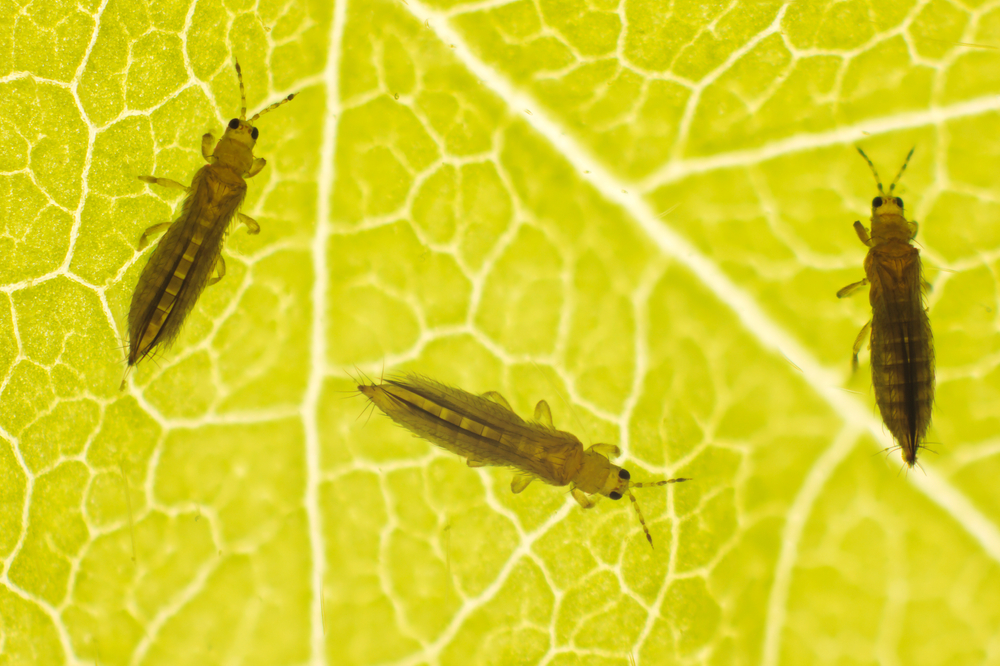
Is your houseplant sad or struggling? There could be many reasons why. Is it getting too much sun, or maybe not enough? Are you underwatering or, more likely, overwatering it? Is the soil packed too densely? Does it need to be fed a fertilizer? Or, even worse, has it been taken over by pests?
Infestations happen, and they are more likely to happen when a plant is stressed or weakened. To prevent infestations, make a habit of checking your plants regularly, looking under leaves and in the soil for bugs and other critters. Prune away leaves that are yellowed, dried out or visibly damaged so there’s no detritus on which pests can feed. Whenever you bring home a new houseplant, quarantine it away from other plants. As we humans have learned, isolation will stop possible diseases or pests from spreading.
If you do have an infestation, the culprit is likely to be one of these common houseplant pests. The sooner you catch them, the easier it will be to get rid of them. If you find any little critters taking over your perfectly potted pothos or other prized plantings, immediately move it away from healthy ones while you address the problem. Here’s how to identify the pests—and more importantly, how to get rid of them.
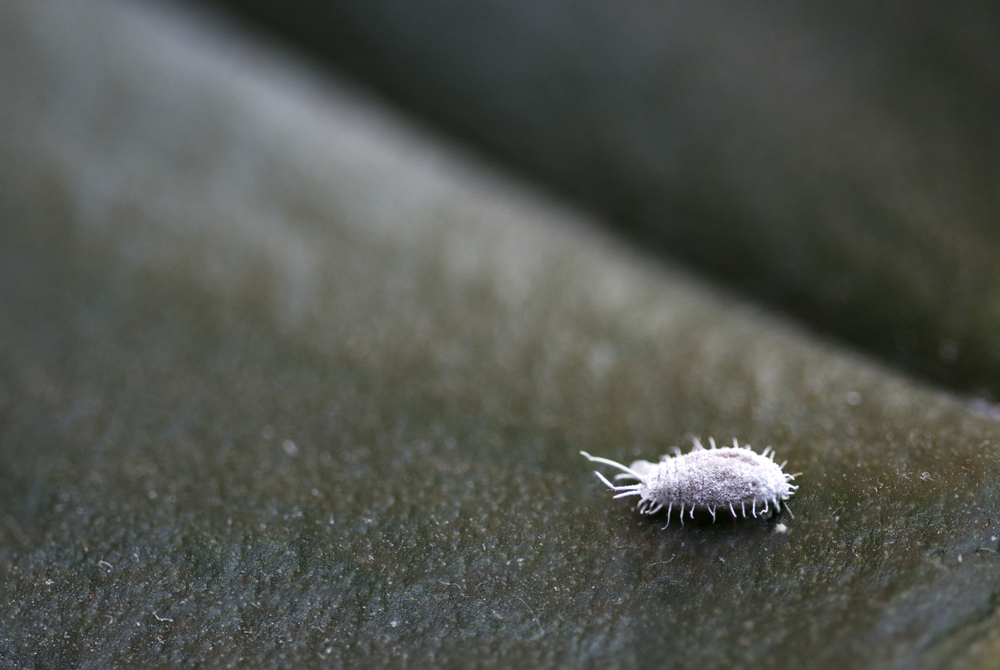
Photo by PopFoto/Shutterstock.
Mealybugs
How to identify: Easily confused for dust, mealybugs are a type of scale insect. These oval-shaped, soft-bodied insects look like little white pieces of dryer lint. They love to suck the life out of your plant, feeding on its juices. You’ll find them festering in small colonies on the undersides of leaves, around new growth and in tiny nooks between the leaves and stems.
How to get rid of them: Mealybugs are persistent and spread quickly, so they can be difficult to get under control. You can start by dipping a cotton swab in alcohol and dabbing each mealybug you see. Then treat the plant with neem oil, an effective fungicide and pesticide that isn’t toxic to humans and pets when used correctly. Dilute 1 teaspoon of neem oil and ½ teaspoon of dish soap with 1 quart of water. Shake it up in a spray bottle and apply it to the plant thoroughly, particularly the undersides of the leaves. Mealybug eggs are resilient, so if the infestation persists a week later, repeat this routine.
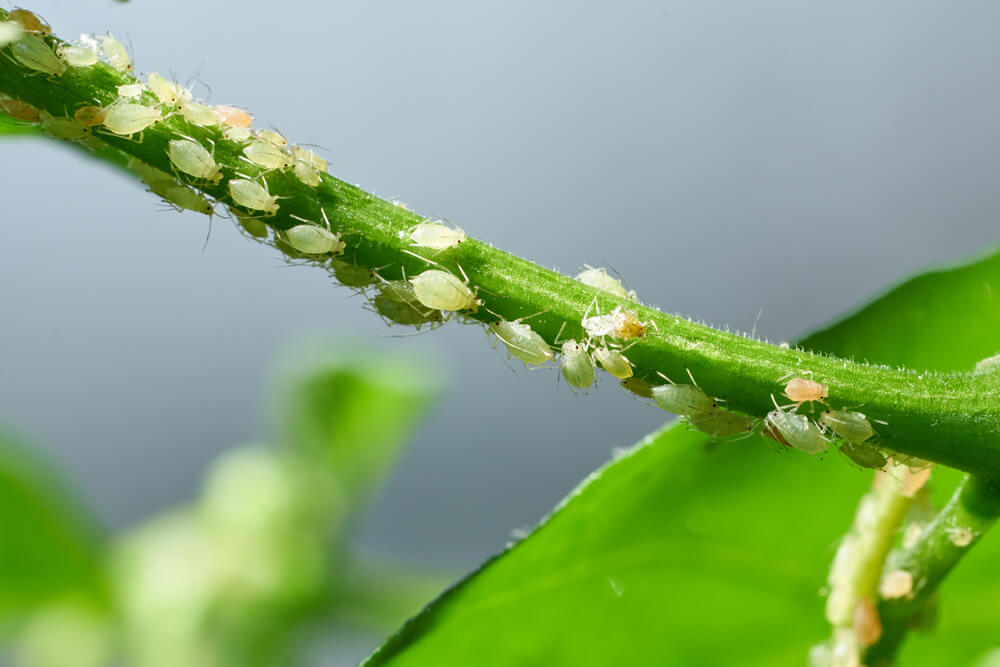
Photo by Aleksandr Rybalko/Shutterstock.
Aphids
How to identify: Small (less than ¼ inch) and soft-bodied, these pesky, pear-shaped insects have long legs and long antennae and can be white, brown, black, light green, orangish and even pink. Aphids prefer new growth and feed on soft stems, branches and buds, piercing the stems and leaves and sucking nutrient-rich sap from the plant. They feed in groups and leave behind yellowed leaves and deformed flowers. They also give birth to live young, meaning they can spread rapidly.
How to get rid of them: Spray aphids off of plants with a strong stream of water from a garden hose or shower head. Pick any remaining ones off and crush them with your fingers. You can also make a homemade spray by mixing 1 tablespoon of a pure liquid soap (such as Castile) with 1 liter of water, then spraying the mixture directly on the affected parts of the plant. Your pre-mixed neem oil spray (see above) is also your friend here.
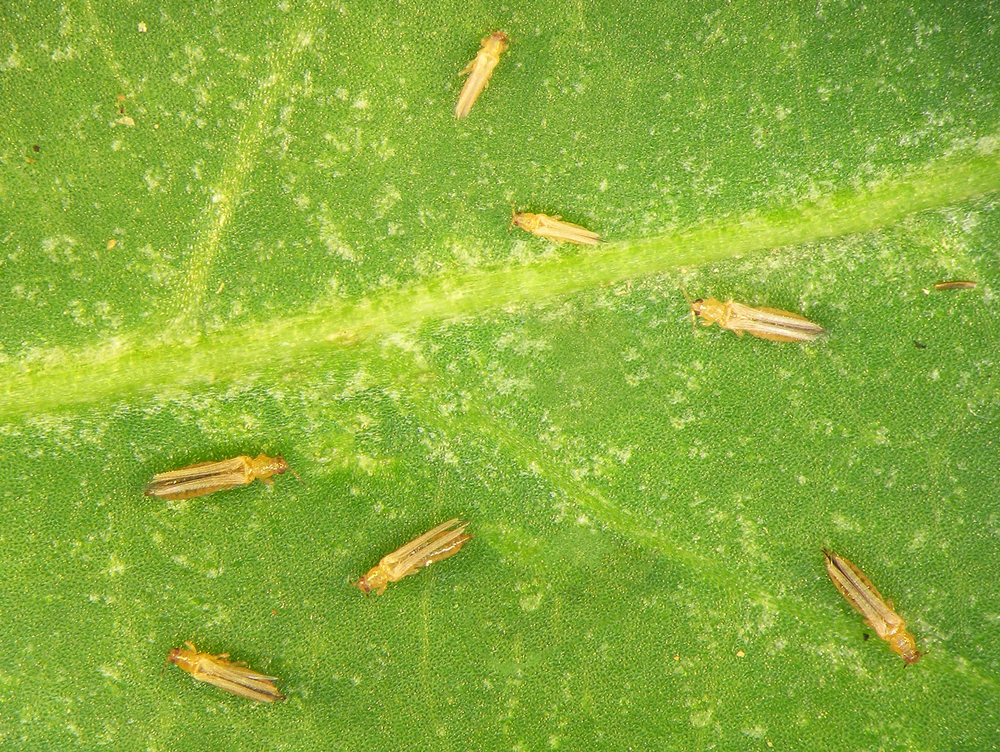
Photo by Protasov AN/Shutterstock.
Thrips
How to identify: Also known as thunderflies, thrips are small, slender, dark-colored bugs that are common garden pests that can get inside and wreak havoc on your indoor plants. The first sign of a thrip infestation is faded or blotchy leaves. You’ll see them crawling—and perhaps flying—as they suck the sap out of leaves, stems, flowers and buds, usually starting on the undersides of the leaves. They also leave droplets of excrement behind, which will look like black, varnish-like specks.
How to get rid of them: Take the affected plant outside or into the shower and rinse off the leaves to quickly knock down their population. Soap kills thrips on contact, so the best route to getting rid of them is by spraying your plant with a pre-mixed organic insecticidal soap or with a diluted mixture of 1 teaspoon of mild liquid soap and 1 liter of water. Again, your trusted neem oil spray is good to use, too.
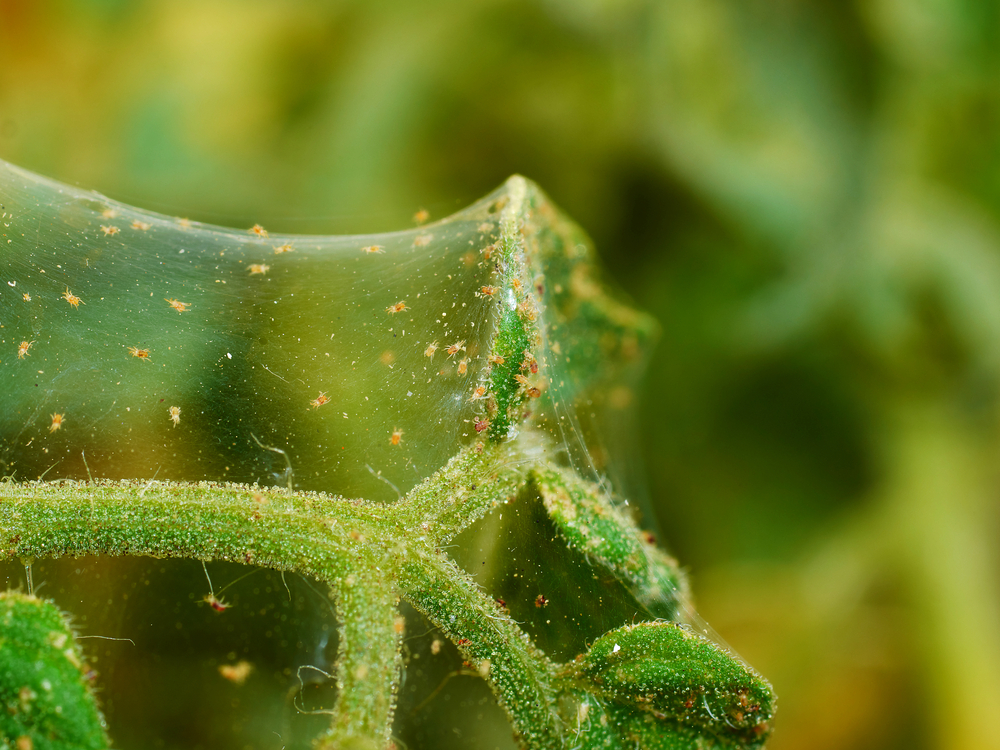
Photo by Floki/Shutterstock.
Spider mites
How to identify: Spider mites are the bane of any plant lover’s existence. They often go unnoticed because people think their tiny webs are normal spiderwebs. Only it isn’t a spider, most of the time, but a nasty little mite that is barely visible to the human eye. They usually start feeding on the underside of plant leaves, and they are most active in dry, hot conditions—such as on a plant positioned near a heating duct. The first sign of a spider mite infestation is plant damage such as light-color speckling on the upper surface of leaves.
How to get rid of them: Dislodge the spider mites and break up their webs with a strong stream of water from a hose or shower head. Plants can also be treated with an insecticidal soap or neem oil spray. It’s often necessary to spray once a week for several weeks to get a spider mite infestation under control.
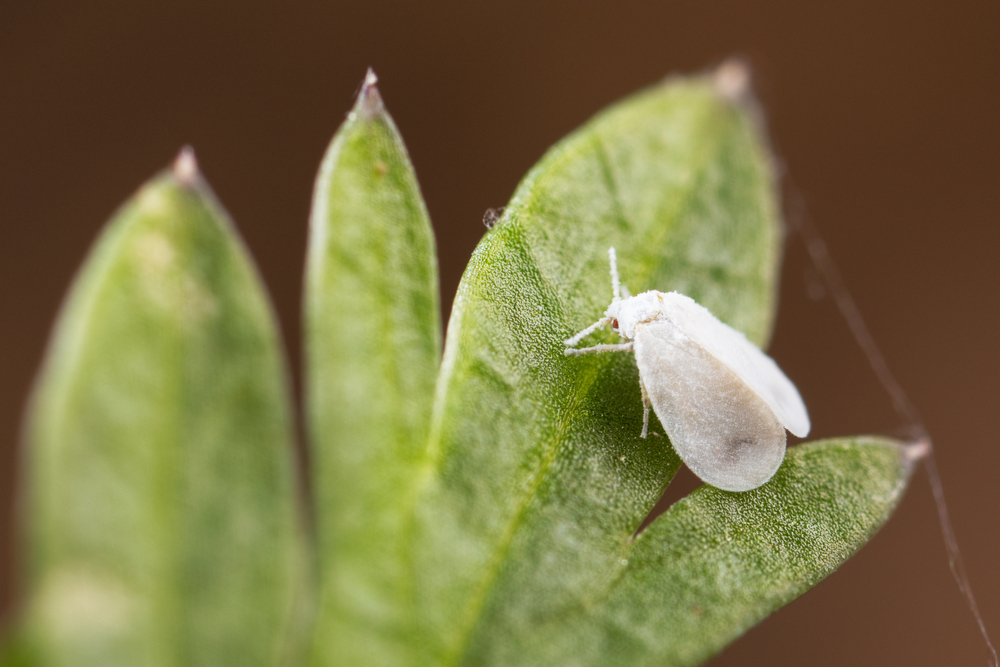
Photo by Ferenc Speder/Shutterstock.
Whiteflies
How to identify: Whiteflies are not actually true flies and are more closely related to mealybugs and aphids. Powdery white in appearance (hence the name), they are very small, usually between 1/10 and 1/16 inches long, and look like little white moths. They suck juices from plants, causing leaves to yellow and fall off.
How to get rid of them: Whiteflies are attracted to the color yellow, so you can catch them using yellow sticky traps. If the problem persists, blast the leaves with short bursts of water, and spray that beloved neem oil mixture on the plant to kill all stages of the pest: eggs, larvae and adults.
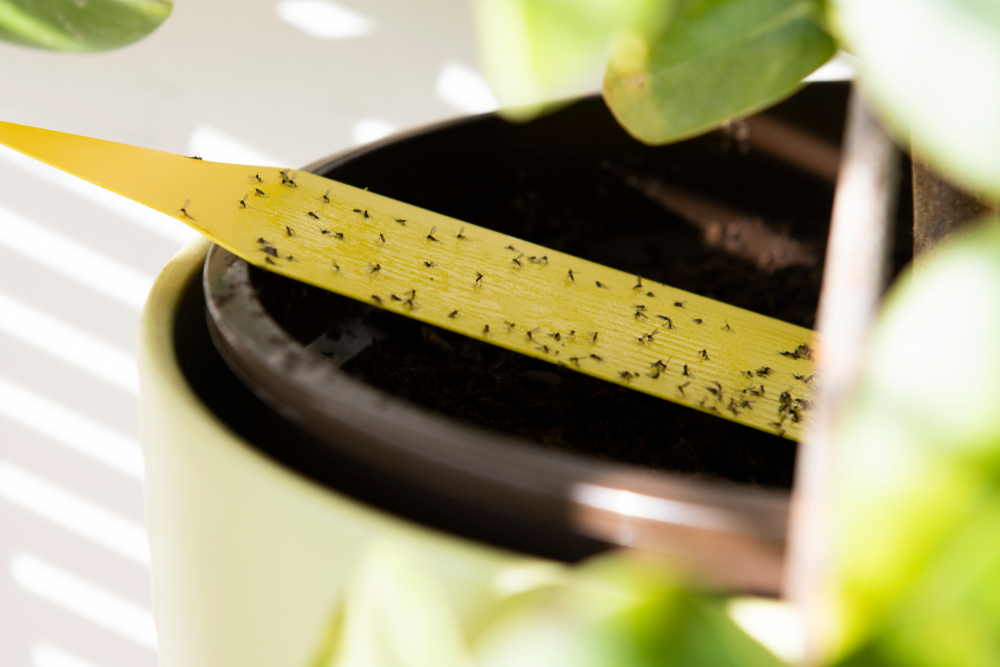
Photo by Anicka S/Shutterstock.
Fungus gnats
How to identify: Gnats are more annoying than they are pest-like and not too problematic for your houseplants. Usually the result of over-watering, these tiny flies breed in damp soil and feed on roots during their larval stage. Once hatched, you’ll see them flying out of your plant’s pot when you water it.
How to get rid of them: Allow your soil to dry out completely and stop overwatering it! You can also use a sticky fly or gnat trap to attract adult gnats. To treat the soil, dilute 3% hydrogen peroxide (1 part peroxide plus four parts water) and water the soil with the mixtures. You can also spray diluted neem oil on foliage to deter adult gnats.
So disappointed that you did not deal with the nasty brown scale which is the bane of my greenhouse. I have been using the firm hose, alcohol swab, and then neem oil spray method which keeps them decreased but never gone. I have to stay so vigilant. I hesitate giving my plants to friends, I would hate to set them up for an infestation!
Please recommend some chemical so I can spray my whole garden because i see some Mealybugs in my plants. I have fogger machine please tell me.
I lost my indoor plants to some insects that looked like Aphids but were only on and in the dirt of the plant pot not on any parts of the plant that was out of the soil. Could they still be a kind of aphid? The one time I was managing to have plants grow and those ugly little pale brownish colony needed to show up and kill them all. They had COVERED all the soil and they were so small that from afar I could never tell that the layer on the top wasn’t soil but a massive population… Read more »